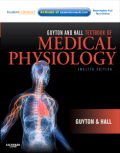
Guyton and Hall textbook of medical physiology: with student consult online access
Hall, John E.
"a bible for physiology, perfect to understand those things you may have not thoroughly understood. [before]" (Medical Student Review)One of the world's favourite physiology textbooks, due to its ability to present complex physiologic principles in language that is easy to read and understand. Now with improved colour artwork, thorough updates to reflect modern medicine and science, anda range of online extras at www.studentconsult.com, this textbook is an excellent source for mastering essential human physiology knowledge. INDICE: I Introduction to physiology: the cell and general physiology 1Functional organization of the human body and control of the 'internal environment 2The cell and its functions 3Genetic control of protein synthesis, cell function, and cell reproductionII Membrane physiology, nerve, and muscle 4The DNA code in the cell nucleus is transferred to an RNA code in the cell cytoplasm -- the process of transcription 5Membrane potentials and action potentials 6Contraction of skeletal muscle 7Excitation of skeletal muscle: neuromuscular transmission and excitation-contraction coupling 8Contraction and excitation of smooth muscleIII The heart 9Cardiac muscle: the heart as a pump and function of the heart muscles 10Rhythmical excitatory and conductive system of the heart 11The normal electrocardiogram 12Electrocardiographic interpretation of cardicamuscle and coronary blood flow abnormalities: vectrial analysis 13Cardiac arrhythmias and their electrocardiographic interpretationIV The circulation 14Overview of the circulation; medical biophysics of pressure, flow, and resistance15Vascular distensibility and functions of the arterial and venous systems 16The microcirculation and lymphatic system: capillary fluid exchange, interstitial fluid, and lymph flow 17Local and humoral control of tissue flow by the tissues 18Nervous regulation of the circulation, and rapid control of arterial pressure 19Role of the kidneys in long-term control of arterial pressure and inhypertension: the integrated system for aterial pressure regulation 20Cardiacoutput, venous return, and their regulation 21Muscle blood flow and cardiac output during exercise; the coronary circulation and ischemic heart disease 22Cardiac failure 23Heart valves and heart sounds; dynamics of valvular and congenital heart defects 24Circulatory shock and physiology of its treatmentV The body fluids and kidneys 25The body fluids compartments: extracellular and intracellular fluids; intersitial fluid and edema 26Urine formation by the kidneys:I. Glomerular filtration, renal blood flow, and their control 27Urine formation by the kidneys: II. Tubular reabsorption and secretion 28Urine concentration and dilution; regulation of extracellular fluid osmolarity and sodium concentration 29Renal regulation of potassium, calcium, phosphate, and magnesium; integration of renal mechanisms for control of blood volume and extracellular fluid volume 30Acid-base regulation 31Diuretics and kidney diseasesVI Blood cells, immunity, and blood coagulation 32Red blood cells, anemia, and polycythemia33Resistance of the body to infection: I. Leukocytes, granulocytes, the monocyte-macrophage system, and inflammation 34Resistance of the body to infection:II. Immunity and allergy 35Blood types; transfusion; tissue and organ transplanation 36Hemostasis and blood coagulationVII Respiration 37Pulmonary ventilation 38Pulmonary circulation, pulmonary edema, pleural fluid 39Physical principles of gas exchange; diffusion of oxygen and carbon dioxide through the respiratory membrane 40Transport of oxygen and carbon dioxide in blood and tissue fluids 41Regulation of respiration 42Respiratory insufficiency - pathophysiology, diagnosis, oxygen therapyVIII Aviation, space, and deep-sea diving physiology 43Aviation, high-altitude, and space physiology 44Physiology of deep-sea diving and other hyperbaric conditionsIV The nervous system: A. General principles and sensory physiology 45Organization of the nervous system, basic functionsof synapses, "Transmitter sybstances" 46Sensory receptors, neuronal circuits for processing information 47Somatic sensations: I. General organization, the tactile and position senses 48Somatic sensations: II. Pain, headache, and thermal sensationsX The nervous system: B. The special senses 49The eye: I. Opticsof vision 50The eye: II. Receptor and neural function of the retina 51The eye: III. Central neurophysiology of vision 52The sense of hearing 53The chemicalsenses - taste and smellXI The nervous system: C. Motor and integrative neurophysiology 54Motor functions of the spinal cord; the cord reflexes 55Cortical and brain stem control of motor function 56Contributions of the cerebellum andbasal ganglia to overall motor control 57Cerebral cortex, intellectual functions of the brain, learning and memory 58Behavioral and motivational mechanismsof the brain - the limbic system and the hypothalamus 59States of brain activity - sleep, brain waves, epilepsy, psychoses 60The autonomic nervous system and the adrenal medulla 61Cerebral blood flow, cerebrospinal fluid, and brain metabolismXII Gastrointestinal physiology 62General principles of gastrointestinal function - motility, nervous control, and blood circulation 63Propulsion and mixing of food in the alimentary canal 64Secretory functions of the alimentary tract 65Digestion and absoprtion in the gastroinestinal tract 66Physiologyof gastrointestinal disordersXIII Metabolism and temperature regulation 67Metabolism of carbohydrates 68Lipid metabolism 69Protein metabolism 70The liver 71Dietary balances; regulation of feeding; obesity and starvation; vitamins andminerals 72Energetics and metabolic rate 73Body temperature, temperature regulation, and feverXIV Endocrinology and reproduction 74Introduction to endocrinology 75Pituitary hormones and their control by the hypopthalamus 76Thyroid metabolic hormones 77Adenocortical hormones 78Insulin, glucagon, and diabetes mellitus 79Parathyroid hormone, calcitonin, calcium and phosphate metabolism, vitamin D, bone, and teeth 80Reproductive and hormonal functions of the mail (and function of the pineal gland) 81Female physiology before pregnancy and female hormones 82Pregnancy and lactation 83Fetal and neonatal physiologyXV Sports physiology 84Sports physiology
- ISBN: 978-1-4160-4574-8
- Editorial: Saunders
- Encuadernacion: Cartoné
- Páginas: 1104
- Fecha Publicación: 16/07/2010
- Nº Volúmenes: 1
- Idioma: Inglés
